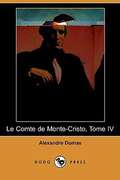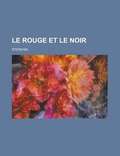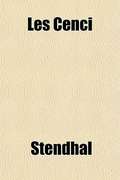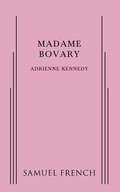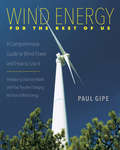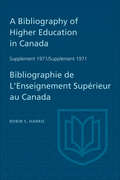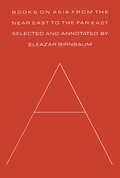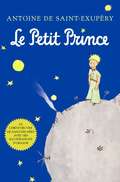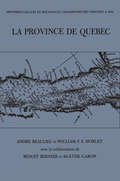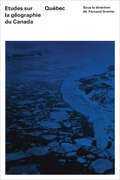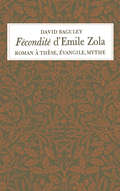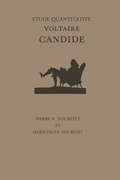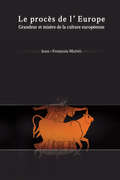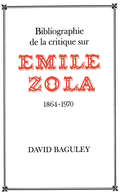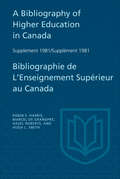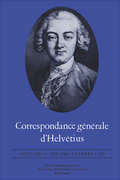- Table View
- List View
Le comte de Monte-Cristo, Tome IV
by Alexandre DumasAlexandre Dumas (1802-1870) est un crivain franais. Il est n Villers-Cotterts (Aisne). Il reut une ducation plutt mediocre. Aprs des tudes ngliges, il travailla comme clerc chez un notaire et dbuta la rdaction de pices de th[tre avec son ami, le vicomte Adolphe Ribbing de Leuven. Ces premiers essais furent autant dchecs. En 1823, il entra au service du Duc dOrlans comme expditionnaire gr[ce sa calligraphie. Il lisait alors Shakespeare, Walter Scott, Goethe et Schiller qui furent les sources dinspiration principales de son th[tre. Il continua crire pour le th[tre et connut enfin le succs gr[ce la reprsentation en 1829 de Henri III et sa cour par la Comdie-Franaise. Ce succs continua pendant toute sa carrire littraire dans ses genres de prdilection: le drame, le roman historique et le feuilleton. Ses oeuvres comprennent: Les Trois Mousquetaires (1844), Le Comte de Monte-Cristo (1845-1846) et Le Vicomte de Bragelonne (1848).
Le Rouge et le noir
by StendhalPublié quelques mois après les Trois Glorieuses de 1830, Le Rouge et le Noir est l'un des deux ou trois plus grands romans du siècle et l'un des chefs-d'œuvre de la littérature universelle. Inspiré d'un fait divers célèbre de l'époque - Antoine Berthet avait été condamné à mort en 1828 par les assises de l'Isère pour tentative de meurtre sur la personne de Mme Michoud chez qui il était précepteur -, Le Rouge et le Noir est l'histoire d'un jeune homme ambitieux qui se sert des femmes pour réussir et qui rachète ses erreurs par une inflexible énergie. Manuel de l'ambition et de la rébellion, Le Rouge et le Noir est aussi et d'abord un roman d'amour. Julien Sorel annonce peut-être, en un sens, la lutte des classes. Marchant dans les pas de Valmont et de Don Juan, il annonce aussi tous les thèmes de la liberté sexuelle d'aujourd'hui. Julien Sorel passe et les femmes tombent dans ses bras. Ce qui frappe, chez Stendhal, c'est le contraste entre l'échec en son temps et son prodigieux succès dans le nôtre. Il a échoué dans la vie et dans sa chasse au bonheur ; il a réussi au-delà de toute espérance dans sa quête de futur." Je mets, disait-il, un billet à la loterie dont le gros lot se réduit à ceci : être lu en 1935 ". Soixante-quinze ans après la date fixée, Stendhal, méprisé et moqué par ses contemporains, est adulé par les nôtres. Valéry et Gide saluent en lui le romancier le plus intelligent de notre littérature et un classique de la modernité.
Les Cenci
by StendhalLe don Juan de Molière est galant sans doute, mais avant tout il est homme de bonne compagnie; avant de se livrer au penchant irrésistible qui l'entraîne vers les jolies femmes, il tient à se conformer à un certain modèle idéal, il veut être l'homme qui serait souverainement admiré à la cour d'un jeune roi galant et spirituel.
L'Étourdi ou les contre-temps
by MolièreL’Étourdi ou les Contretemps ou L'estourdy ou les contre-temps, est une comédie en cinq actes et en vers de Molière, représentée pour la première fois à Lyon en 1653. Elle a été représentée la première fois à Paris au Théâtre du Petit-Bourbon le 3 novembre 1658 par la troupe de Monsieur, frère unique du Roi.
Madame Aubin
by Paul VerlaineNouvelle édition de Madame Aubin de Paul Verlaine augmentée d'annexes (Biographie). L'ouvrage a été spécifiquement mis en forme pour votre liseuse. - Naviguez par simple clic de chapitre à chapitre ou de livre à livre. - Accédez instantanément à la table des matières hyperliée globale. - Une table des matières est placée également au début de chaque titre. A PROPOS DE L'ÉDITEUR : Les éditions Arvensa sont les leaders de la littérature classique numérique.Leur objectif est de vous faire connaître les oeuvres des grands auteurs de la littérature classique en langue française à un prix abordable tout en vous fournissant la meilleure expérience de lecture sur votre liseuse.Tous les titres sont produits avec le plus grand soin. Le service qualité des éditions Arvensa s’engage à vous répondre dans les 48h. Retrouvez tous les titres sur leur site.
Madame Bovary
by Gustave FlaubertLa novela más conocida de Gustave Flaubert y una de las grandes obras de la literatura universal nos acerca a la historia de Emma Rouault. Una joven de origen campesino y huérfana de madre que contrae matrimonio con el médico Charles Bovary. El afán por ser la protagonista de una vida romántica presidida por el amor, ambición que su marido no puede satisfacer, será la perdición de la ingenua muchacha, que buscará por todos los medios, con aventuras y con amantes, escapar al tedio, la monotonía y la exasperación que se han apoderado de su vida. La presente edición, en reciente traducción de Mauro Armiño, incluye los fragmentos, descubiertos entre los manuscritos de Flaubert, que el autor decidió a última hora no incluir en la novela. Completan el volumen un estudio introductorio de Jacques Neefs, de la Johns Hopkins University, y una cronología flaubertiana. «Intentaba saber qué se entendía exactamente en la vida por las palabras "felicidad", "pasión" y "ebriedad", que tan hermosas le habían parecido en los libros. » ENGLISH DESCRIPTION The notorious and celebrated novel that established modern realism For this novel of French bourgeois life in all its inglorious banality, Flaubert invented a paradoxically original and wholly modern style. His heroine, Emma Bovary, a bored provincial housewife, abandons her husband to pursue the libertine Rodolphe in a desperate love affair. A succès de scandale in its day, Madame Bovary remains a powerful and scintillating novel. This Penguin Classics edition is translated with notes and an introduction by Geoffrey Wall. It includes a preface by Michele Roberts. For more than seventy years, Penguin has been the leading publisher of classic literature in the English-speaking world. With more than 1,700 titles, Penguin Classics represents a global bookshelf of the best works throughout history and across genres and disciplines. Readers trust the series to provide authoritative texts enhanced by introductions and notes by distinguished scholars and contemporary authors, as well as up-to-date translations by award-winning translators.
Poil de Carotte
by Jules RenardCette uvre (edition relie) fait partie de la serie TREDITION CLASSICS. La maison d'edition tredition, basee a Hambourg, a publie dans la serie TREDITION CLASSICS des ouvrages anciens de plus de deux millenaires. Ils etaient pour la plupart epuises ou uniquement disponible chez les bouquinistes. La serie est destinee a preserver la litterature et a promouvoir la culture. Avec sa serie TREDITION CLASSICS, tredition a comme but de mettre a disposition des milliers de classiques de la litterature mondiale dans differentes langues et de les diffuser dans le monde entier.
Wind Energy for the Rest of Us
by Paul GipeWind Energy for the Rest of Us straddles two—or more—worlds. The book is about wind energy. It’s not just about small wind turbines. It’s not just about large wind turbines. It’s about the depth and breadth of wind energy, encompassing more than either type of wind turbine. It includes water-pumping windmills and sailing ships. It’s a sprawling book, one minute discussing how to install small wind turbines safely, the next explaining how farmers in Indiana can earn millions by installing their own multimegawatt wind turbines. If it’s a book hard to categorize, that suits its author, Paul Gipe, who likes to think he’s hard to categorize after four decades at the frontiers of renewable energy. His book tells the story of modern wind energy in all its complexity and introduces a North American audience to the trailblazing electricity rebels who have launched a renewable energy revolution in Europe. The book debunks novel wind turbines their promoters claim will generate electricity “too cheap to meter,” and rebukes revisionist historians who falsely argue that it was the aerospace industry that delivered today’s modern wind turbines. Gipe explains why new wind turbines are part of a silent revolution that is changing the way we use wind energy. This revolution doesn’t garner headlines, but is making wind turbines more cost-effective in more places than ever before, lessening the need for new transmission lines, obviating the need for storage, and fueling rapid growth. Gipe refutes many common myths surrounding wind energy and argues persuasively that wind turbines are productive, effective, and environmentally sound. Gipe argues that wind energy is too important to be left to electric utilities and their subsidiaries alone. Wind energy is also for the rest of us, he says. It is our resource. We can develop it and we can own it--ourselves.
A Bibliography of Higher Education in Canada Supplement 1971 / Bibliographie de l'enseignement superieur au Canada Supplement 1971
by Robin HarrisThe 1971 Supplement adds some 3,500 entries to the approximately 7,000 listed in the original volume and the 1965 Supplement. Like its predecessors this volume provides a full list of the secondary sources related to Canadian higher education – books, articles, theses, dissertations, and reports published from 1964 to 1969. The reporting and arrangement of entries remains the same in the Supplement, but changes have been made in the overall organization of the material. New divisions have been created, more than a dozen sections have been subdivided, and a substantial number of new sections have been added. (Studies in Higher Education 5)
Books on Asia from the Near East to the Far East
by Eleazar BirnbaumThis is a selected, annotated list of some 2,000 books on Asia in English and French currently in print, chosen with the aim of providing a long-term historical perspective for the general reader. The list is presented in four main parts: Asia as a whole; the Islamic world; India, South and Southeast Asia; the Far East. Subdivisions cover such topics as: general and reference works; history, social science, and law; history of literature; literature in translation; religion and ideas; arts, crafts, architecture, and science; and the lands in modern times.
Le Petit Prince: The Original French Edition
by Antoine de Saint-ExupéryThis timeless classic was embraced by critics and readers across the coun try for its purity and beauty of expression. Saint-Exupry's beloved artwork was restored and remastered to present his work in its original vibrant colors.
Le province de Quebec
by Agathe Garon W.F.E. Morley André Beaulieu Benôit BernierThere is no doubt that local and regional history, considered by many as a kind of minor historical study, has a pressing need for a systematic inventory of its resources. This collection shows the durability, the vividness, and the astonishing productivity of a sector of history which is the stronghold of the history-lover rather than the professional historian.The nature and content of each book determines its selection. For each book included, the compilers have weighed its contribution to local history and regional history rather than the style in which it is written--narrative, memoir, descriptive study, or novel. It is this criterion of selection that has permitted the retention of several general histories of a varied nature--Bouchette, Charlevoix, Nicholas Denys, La Potherie, Lescarbot, Hanotaux, Sulte, etc.-- where local and regional life takes on a major importance for reasons of order in history, method, or quite simply because local life is the principal object of the study itself. The editors have also retained certain works--those of George W. Brown, Arthur Buies, George M. Grant, Blodwen Davies, etc.--because they are primarily descriptive and contain numerous elements in which local history blends with the manners and customs of the inhabitants of certain regions.This bibliography is designed primarily for historiographers who have until now paid little attention to local, regional, or parochial history. It will also be invaluable for librarians who suffer from the numerous difficulties involved in the classification of such works. Since 1950, all works published in Canada are, by virtue of the book deposit law, provided to the National Library of Canada, and recorded in Canadiana.
Etudes sur la Geographie du Canada
by Fernand GrenierThe publication of the series, 'Studies in Canadian Geography,' by the organizers of the 22nd International Geographical Congress, introduces to the international community of geographers a new perspective of the regional entities which form this vast countries. These studies should contribute to a better understanding among scholars, students, and the people of Canada of the geography of their land. Geographical works embracing the whole of Canada, few in number until recently, have become more numerous during the last few years. This series is original in its purpose of re-evaluating the regional geography of Canada. In the hope of discovering the dynamic trends and the processes responsible for them, the editors and authors of these volumes have sought to interpret the main characteristics and unique attributes of the various regions, rather than follow a strictly inventorial approach. In preparing this volume on Quebec, the contributors have looked at the evolution and present patterns of the ecumene of southern Québec, rural and urban Québec, and the dynamic biogeography of Québec.
Fecondite d'Emile Zola
by David BaguleyThis historical and critical study of Zola's Fécondité contributes much to an understanding of how the novel came to be written and of its achievements. Like Travail and Verité, the later books in the series Les Quatre Evangiles, Fécondité has not previously received significant critical attention. This study reveals and interprets the less obvious aspects of the work, its biblical and mythical themes, its sources and genesis. It also adds to our knowledge of Zola's later works through the examination of various ideological currents--particularly the impact of Malthusianism, its proponents and adversaries, and who among them Zola read in preparing this book. Fécondité deals with the particular problem of France's declining birth-rate at the end of the nineteenth century and, more generally, with the problem of decadence and cultural renewal. By the time that he wrote Fécondité, Zola had abandoned his naturalist aesthetic of scientific objectivity, if not also his working methods as a novelist. This study shoes how his didactic concerns continually asserted themselves in the structure and the use of rhetorical techniques in Fécondité. Specialists in Zola, and others more generally interested in the French culture of the late nineteenth century, as well as the particular demographic problems that Zola treats in the work, and the relationship of literature to primitive mythology, should find this study of particular interest.
Voltaire's Candide: Etude quantitative
by Marie-Paule Ducretet-Powell Pierre DucretetQuantitative studies furnish precise and complete numerical data about the nature of literary language and language in general. They provide the foundation for qualitative studies that can contribute to the analysis, interpretation and understanding of style, language, and ideas for a given period or author. This volume is a quantitative examination of Voltaire's Candide. It includes a word frequency dictionary, index verborum, and line concordance keyed to a text of Candide which is reproduced in the volume, as well as a lengthy introduction that describes and interprets the quantitative data. Linguists, statisticians, lexicographers, and literary scholars will find this work of interest, not only for the vital data that is supplies, but also for the methodology that underlies it.
Le Procès de l'Europe: Grandeur et misère de la culture européenne (Philosophica)
by Jean-François MattéiL’Europe se trouve aujourd’hui en position d’accusée, souvent par les Européens eux-mêmes, du fait de sa prétention à l’universalité, de sa supériorité proclamée et de son arrogance intellectuelle. Qu’elle n’ait pas toujours été fidèle à ses principes, lors de la colonisation des autres peuples, ne met pourtant pas en cause sa légitimité. La critique de l’Europe n’est en effet possible qu’à l’aide des normes juridiques et des principes éthiques qu’elle a diffusés auprès de tous les peuples pour connaître le monde plutôt que pour le juger.Levinas n’avait donc pas tort de louer «la générosité même de la pensée occidentale qui, apercevant l’homme abstrait dans les hommes, a proclamé la valeur absolue de la personne et a englobé dans le respect qu’elle lui porte jusqu’aux cultures où ces personnes se tiennent et où elles s’expriment.» Il faut en prendre son parti : il n’y a pas plus d’égalité des cultures que de relativisme des valeurs. On ne saurait faire le procès de l’universel sans faire appel à la culture qui a donné cet universel en partage aux autres cultures.
Bibliographie de la Critique sur Émile Zola, 1864-1970
by David BaguleyZola scholars and those whose work in other fields--literary, historical, sociological, or artistic--brings them into contact with Zola and his works have long felt the need for a survey for the large corpus of writings on this important, widely read author. This bibliography provides just such a survey, admirably complete and intelligently organized. Aided in his research by several collaborators and by a number of libraries throughout the world, David Baguley has compiled some 8000 items covering the period from the first reviews of Zola's early works to 1970. Although his work does not pretend to be exhaustive, it contains extensive coverage of studies in English, German, Polish, and Spanish, as well as French, as essential items in many other languages. The entries are arranged chronologically by years and, within each year, alphabetically by author. An introduction outlines aims, principles, and uses. Researchers will also find helpful the list of unpublished theses on Zola from various countries, the index of authors' names and names appearing in titles and notes, and the index of themes. The latter uses the number assigned to each of the entries to facilitate speedy location of materials on particular topics--e.g. Germinal studies, Zola and the theatre, the Dreyfus case, and so on. Wherever appropriate, annotation has been provided that indicates the language, content, importance, and viewpoint of the items. This bibliography will be an indispensable reference guide for Zola scholarship.
A Bibliography of Higher Education in Canada Supplement 1981 / Bibliographie de l'enseignement supérieur au Canada Supplément 198
by Robin Harris Marcel De Grandpre Hazel Roberts Hugh SmithThe 1981 Supplement adds more than 3000 entries to the approximately 10,500 listed in the original volume and in the 1965 and 1971 Supplements. Like its predecessors, this volume provides a full list of the secondary sources related to Canadian higher education – books, articles, theses ,dissertations, and reports published from 1971 to 1980. The reporting, arrangement of entries, and overall organization of the material remains the same as in the 1971 Supplement.
Correspondance générale d'Helvétius, Volume I: 1737-1756 / Lettres 1-249
by Alan Dainard Claude Adrien Helvétius David Smith Jean Orsoni Peter AllanThis volume is the first of three in a complete critical edition of the letters of Claude-Adrien Helvétius (1715-71) and his wife, née Anne Catherine de Liginville (1722-1800). Though rank and wealth, Helvétius was acquainted with the leading political and social figures of his time, and, through family, with court and government which he occasionally served in a diplomatic capacity. Philosopher and author of the explosive De l'esprit, Helvétius corresponded with the great and the influential throughout Europe. His letters, and those of Mme Helvétius, provide insights into, and new information about, their lives and the political, social, and intellectual history of the eighteenth century. Volume I contains almost 250 letters written by or to Helvétius or his wife. Of these, the largest collections are those from Helvétius to Mme Helvétius, made available by his descendants, and letters from the future Mmem Helvétius to her aunt, Mme de Graffigny, which are at Yale University. Letters to or from third parties are also included. Much of this correspondence has never before been published. Correspondance générale d'Helvétius is fascinating to read; it is indispensable for future study of Helvétius' life and work and of Mme Helvétius' influence on her husband his his circle. This volume has a preface by Comte Charles-Antoine d'Andlau, a descendant of Helvétius, and an introduction by the editors setting out their editorial and critical principles and system of annotation. (University of Toronto Romance Series 41)
